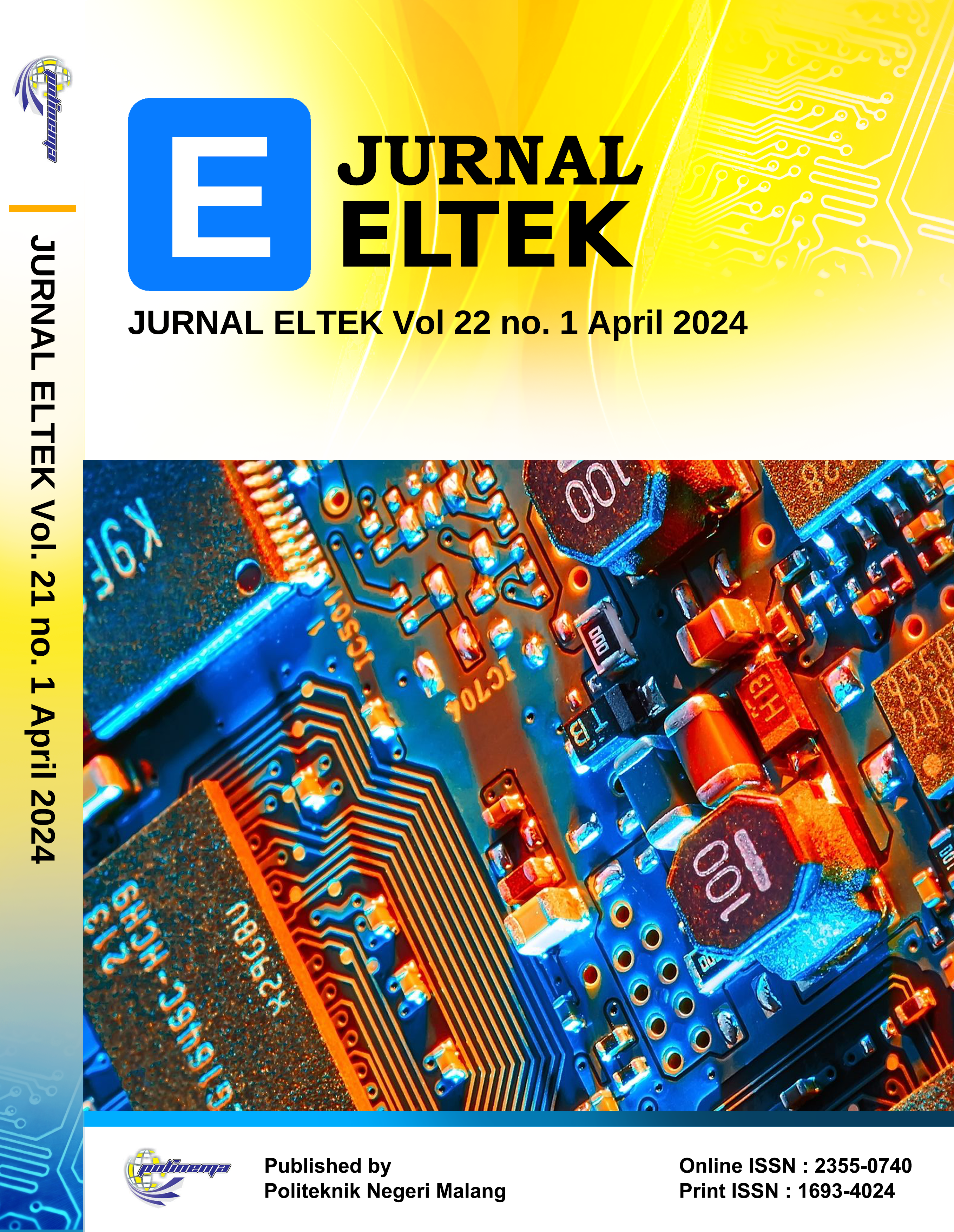Kontrol tegangan pada terminal generator menggunakan AVR berbasis neural network
DOI:
https://doi.org/10.33795/eltek.v22i1.4693Keywords:
Synchronous Generator, AVR, Neural NetworkAbstract
Generator sinkron mempunyai permasalahan yaitu Ketidak stabilan tegangan pada generator sinkron menyebabkan sistem secara keseluruhan terutama kualitas sistem, kemampuan transfer daya dari pembangkit ke konsumen, kondisi terparah terjadinya mekanisme pelepasan beban dengan demikian maka diperlukan peralatan yang dapat mengendalikan kestabilan tegangan generator sinkron yaitu Automatic Voltage Regulator (AVR). AVR adalah suatu perangkat yang dipasang pada generator yang dapat bekerja secara otomatis mengatur tegangan yang dihasilkan oleh generator agar tetap stabil. Penelitian ini mengontrol tegangan generator agar stabil menggunakan metode Neural Network (NN). Data penelitian NN diambil dari input dan output kendali PID dengan Sistem AVR yang sama. AVR sederhana dengan respon delay time rise time , peak time settling time , max overshoot dan untuk error steady state . AVR sederhana respon tidak terdapat overshoot dan respon waktunya lebih lambat 5,039s, konvensional terdapat overshoot yang tinggi dan lebih cepat 0,715s, NN respon yang didapatkan overshoot pada waktu 2,456s dan adanya usaha perbaikan respon tegangan kembali ke Vref
ABSTRACT
Synchronous generators have problems with the instability of the voltage, causing the system as a whole, especially the quality of the system and the ability to transfer power from the generator to the consumer, the worst condition is load shedding. Therefore, equipment is required to control the voltage stability of the synchronous generator with the automatic voltage regulator (AVR). AVR is installed on a generator to work automatically to regulate the voltage so that is remains stable. The generator voltage can be stably controlled using the neural network (NN) method. NN training data is obtained from the input and output of PID control with the exact AVR system. Simple AVR with response delay time rise time , peak time settling time max overshoot and error steady state . Simple AVR response has no overshoot, and the response time is slower at 5,039s, conventional has a high overshoot and is faster at 0,715s. NN response obtains overshoot at 2,456s, and there is an effort to improve the voltage response to Vref.
References
A. Nurdin, A. Azis, and R. A. Rozal, “Peranan Automatic Voltage Regulator Sebagai Pengendali Tegangan Generator Sinkron,” J. Ampere, vol. 3, no. 1, p. 163, 2018.
I. Priyadi, “Analisis Pengaruh Eksitasi Terhadap Efek Harmonisa Pada Hubungan Belitan Generator Sinkron Dengan Beban LHE,” J. llmiah Bid. Tek. Elektro dan Komput., vol. 2, no. 1, pp. 40–44, 2012.
Stephen J. Chapman, Electric Machinery Fundermentals. 2012.
Taylor, Synchronous Generators Second Edition By Ion Boldea. 2016.
A. B. D. A. Alam and N. Taryana, “Pemodelan dan Simulasi Automatic Voltage Regulator untuk Generator Sinkron 3 kVA Berbasis Proportional Integral,” J. Reka Elkomika, vol. 3, no. 2, pp. 97–110, 2015.
T. Rahmawati, “Penerapan Metode Elman Recurrent Neural Network Dan Principal Component Analysis (Pca) Untuk Peramalan Konsumsi Listrik the,” Ugm, vol. 53, no. 9, pp. 1689–1699, 2019.
S. Suwarni and A. M. Prasetia, “Pengaturan kecepatan motor induksi tiga fasa dengan direct torque control menggunakan jaringan saraf tiruan,” J. Eltek, vol. 20, no. 2, p. 24, 2022.
R. Riyanda, A. H. H. Pardede, and R. Saragih, “Jaringan Syaraf Tiruan Memprediksi Kebutuhan Obat-Obatan Menggunakan Metode Backpropagation ( Studi Kasus : UPTD Puskesmas Bahorok ),” Semin. Nas. Inform., pp. 47–55, 2021.
A. L. Unihehu and I. Suharjo, “The Klasifikasi Jenis Ikan Berbasis Jaringan Saraf Tiruan Menggunakan Algoritma Principal Component Analysis (PCA),” J. Ilm. Ilmu Komput., vol. 7, no. 2, pp. 27–32, 2021.
E. D. Handoyo and L. W. Susanto, “Penerapan Jaringan Syaraf Tiruan metode Propagasi Balik Dalam Pengenalan Tulisan Tangan Huruf Jepang Jenis Hiragana dan Katakana,” Informatika, vol. 7, no. 1, pp. 1–112, 2011.
D. H. Tanjung, “Jaringan Saraf Tiruan dengan Backpropagation untuk Memprediksi Penyakit Asma,” Creat. Inf. Technol. J., vol. 2, no. 1, p. 28, 2015.
N. Nurmila, A. Sugiharto, and E. A. Sarwoko, “Algoritma Back Propagation Neural Network Untuk Pengenalan Pola Karakter Huruf Jawa,” J. Masy. Inform., vol. 1, no. 1, pp. 1–10, 2010.
M. Fajar, “Peramalan Produksi Cabai Rawit Dengan Neural Network,” no. August, pp. 1–10, 2017.
J. Feng and S. Lu, “Performance Analysis of Various Activation Functions in Artificial Neural Networks,” J. Phys. Conf. Ser., vol. 1237, no. 2, 2019.
G. Dewantoro and J. N. Sukamto, “Implementasi Kendali PID Menggunakan Jaringan Syaraf Tiruan Backpropagation,” Elkha, vol. 11, no. 1, p. 12, 2019.
Downloads
Published
How to Cite
Issue
Section
License
Copyright (c) 2024 Linda Sartika, Abdul Muis Prasetia, Fitri Ramadhan Sudirman

This work is licensed under a Creative Commons Attribution-ShareAlike 4.0 International License.







